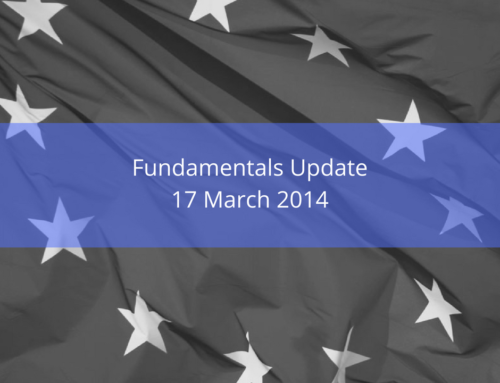US Taper
Fundamentals Update as at 19 December 2013 by Lorenzo Beriozza
The facts behind yesterday FOMC’s decision of starting the tapering are:
- The Federal Open Market Committee decided to reduce the scale of its monthly asset purchases by $10 billion starting in January 2014. As a result, the Committee will add to its holdings of agency mortgage-backed securities at a pace of $35 billion per month rather than $40 billion per month, and will add to its holdings of longer-term Treasury securities at a pace of $40 billion per month rather than $45 billion per month.
- The statement emphasises that these “sizeable and still-increasing holdings of longer-term securities should maintain downward pressure on longer-term interest rates, support mortgage markets, and help to make broader financial conditions more accommodative”.
- A refinement to the forward guidance statement was also introduced. “The Committee now anticipates, based on its assessment of these factors, that it likely will be appropriate to maintain the current target range for the federal funds rate well past the time that the unemployment rate declines below 6-1/2 percent, especially if projected inflation continues to run below the Committee’s 2 percent longer-run goal.”
- Eric S. Rosengren dissented with the vote. He believes that changes in the purchase program are premature until incoming data more clearly indicate that economic growth is likely to be sustained above its potential rate, given that the unemployment rate is still elevated and the inflation rate remains well below the federal funds rate target.
- One important piece of information provided by Chairman Bernanke is the likely path of the tapering. He repeatedly said that the program was not on a pre-set course and was data-dependent, but also stated that the pace of monthly purchases could be reduced by the same amount ($10 billion) at each meeting. Were economic conditions disappointing, they would skip one meeting. Were they booming, they would slow harder.
- FOMC members did not significantly change their forecasts. For this year, the median is slightly down as for GDP growth and the unemployment rate, and slightly down for PCE inflation. Beyond that date, modifications are hard to spot. In short, the consensus among Fed officials is for GDP growth to accelerate progressively, from 2.3% in 2013 to 3.0% in 2014 and 3.2% in 2015, which will drive the unemployment rate close to its equilibrium level by the end of 2015.
- The post-meeting announcements included updated FOMC economic projections and participants’ latest preferences for the path of the fed funds rate target. As expected, the central tendency of FOMC members unemployment rate forecasts were nudged down, given the surprise drop to a 7.0% rate in November. And the ranges for inflation were lowered as well for both 2013 and 2014.
- FOMC softened the language on inflation by saying that “it is monitoring inflation developments carefully for evidence that inflation will move back towards its objective over the medium term”.
- The market reaction has been quite moderate so far as they seemed prepared for this taking place either this month or next, which probably explains the muted reaction. The Fed also generally kept to very cautious language on the economy as well, although they did say that risks appeared “nearly balanced” rather than to the downside.
The key implications of this decision are:
- Macroeconomic data has incrementally improved in recent weeks and the recent fiscal budget deal removed a significant dose of uncertainty from the horizon. This provided enough reassurance to the FOMC to start tapering, even in a seasonally low liquidity environment.
- The change to the forward guidance statement, but not to the specific inflation and unemployment rate thresholds, seeks to reassure market participants that interest rates will remain low for a prolonged period of time. The decline in the unemployment rate to 7% in November poses no risk of an earlier increase in the fed funds rate. This is also consistent with the slightly lower unemployment rate projections relative to September that FOMC members released in conjunction with today’s statement.
- The explicit mention that Fed’s assets holdings remain “sizeable and still-increasing” should be read as a reminder that “tapering is not tightening”, another token in the FOMC’s effort to refine and reinforce its forward guidance.
- The 6-basis point decline in 10-year Treasury yields following the release of the statement appears as a vote of confidence by the markets.
- Next year is likely to be quite bumpy. The very economic conditions that would allow the Fed to wind down QE3 smoothly are conditions that can be expected to cause some friction between the Fed’s accommodative intentions and the markets’ rate hike expectations. The key challenge for the Central Bank is to maintain the markets’ belief in the FOMC’s commitment to targeting exceptionally low policy rates. As QE is wound down and economic recovery progresses, the Fed’s forward guidance will be tested, probably on numerous occasions. Under presumed Chair Yellen, the confrontation will be likely to spark between the Fed’s patient accommodation and the markets’ impulsive tendencies.
Sources: BNP Paribas, TD Economics, Credit Suisse, Danske Bank


